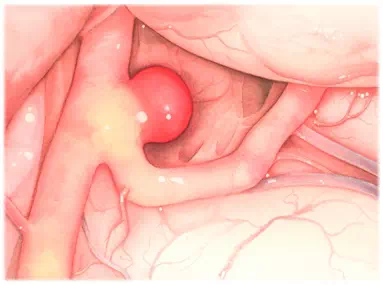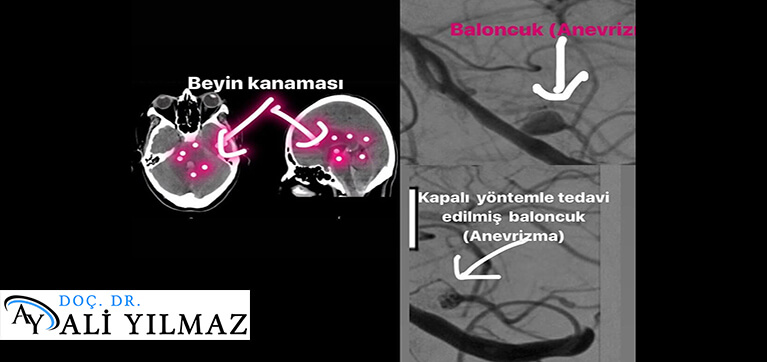A brain aneurysm is the main cause of brain bleeding. Many people think that a brain hemorrhage only occurs in accidents or when they hit their head hard. On the contrary, aneurysm disease is one of the most important factors that cause brain hemorrhage. For this reason, it is important to have information about aneurysms, Increasing our level of awareness as a society will lead to a decrease in mortality rates due to brain hemorrhage. In this article, what is an aneurysm, diagnosis, treatment, You will find information on symptoms, risk groups, surgery, etc.
What is an aneurysm?
An aneurysm is a bubble that forms on blood vessels in the body. A brain aneurysm is the formation of a bubble on the vessels under the arachnoid membrane surrounding the brain. This bubble can cause bleeding as a result of the vessel becoming thinner and weaker over time, leading to cerebral hemorrhage. Aneurysm in the brain, popularly known as a bubble in the brain, A brain bubble is also called cerebral vasodilation.
An aneurysm appears as a bubble in the part of the vessel that expands and then weakens and thins. In most cases, it does not show early symptoms, Even if he or she has an aneurysm, he or she may not realize it. This is the most dangerous situation. Because an aneurysm can lead to a brain hemorrhage. The asymptomatic patient is usually brought to the hospital as an emergency after suffering a brain hemorrhage. These cases require urgent intervention, These are very difficult cases for both the physician and the patient, which may result in patient loss.

What is the incidence of an aneurysm?
Brain aneurysms usually occur in people between the ages of 40 and 60. Of course, this does not mean that it is not seen in other age groups. The incidence rate is between ten and sixteen in every hundred thousand people. The incidence increases with advancing age. It is more common in women than men. The important thing is to diagnose the aneurysm before it ruptures and causes cerebral hemorrhage and to prevent the rupture, that is, to treat the aneurysm.
What causes a bubble in the brain?
Risk factors for the formation of bubbles in the brain are familial, i.e. genetic factors, smoking and alcohol use, hypertension, oral contraceptives, cocaine, drug habits such as amphetamines, drug abuse.
Is an aneurysm genetic?
According to research, people with a family history of aneurysm and cerebral hemorrhage are more likely to develop a brain bubble than other individuals. As the number of individuals with a history of cerebral hemorrhage in the patient's blood relatives increases, the genetic predisposition, and therefore the likelihood of developing an aneurysm, also increases.
Is an aneurysm congenital?
An aneurysm is not a congenital disease. However, it can be caused by a part of the brain vessel being weaker or wider from birth. can lead to the development of an aneurysm later in life
Aneurysm Symptoms
The most common symptoms of an aneurysm are severe headache and neck stiffness. In addition, nausea, vomiting, dizziness, double vision, seizures, confusion and there may be signs of intracerebral hemorrhage that may be associated.
An aneurysm is usually asymptomatic. In addition, even if it is symptomatic, the most common symptom is severe headache. Because they can be mistaken for other conditions, it may not be recognized that an aneurysm is the source of the person's discomfort. Often the bubble in the brain is accidental, other conditions are recognized after imaging in terms of other conditions. Unfortunately, in a significant proportion of aneurysm cases, brain hemorrhage is the first symptom. as an aneurysm. If the presence of an aneurysm in the patient is recognized before bleeding, it is a very good situation for both the patient and the physician. Because in cases where the presence of an aneurysm occurs in the form of cerebral hemorrhage, very serious consequences occur and life risks occur.
With all these, we can list the most common symptoms in patients with brain aneurysm as follows:
● Unusually frequent and severe headache
● Nausea - vomiting
● Dizziness
● Double vision
● Neck stiffness
● Eyelid drooping
Aneurysm diagnosis
The first diagnostic method for a brain aneurysm is to detect bleeding with computed tomography, which gives fast results. After the detection of bleeding, angiography is performed to visualize the brain vessels. If an aneurysm is detected as a result of angiography, then depending on its location and configuration, surgical or endovascular The aneurysm needs to be taken out of circulation.
Brain angiography is the most important imaging technique in the diagnosis of aneurysms. Apart from this, other imaging techniques such as mr, Imaging methods such as computed tomography also provide important data for diagnosis. Thanks to developing technology, aneurysms Their location and position can be clearly determined. This allows the physician to make the most appropriate decision for intervention and treatment.
Early diagnosis of an aneurysm is vital. For this reason, those in the risk group, i.e. those with a genetic predisposition and people between the ages of 40 and 60, Especially if they have the symptoms of an aneurysm mentioned above, most importantly if they have recurrent headaches, they should definitely be examined for an aneurysm.
What happens if an aneurysm bursts?
An aneurysm appears as a bubble in the brain. The vessel where the bubble is located is thinned and weakened. Over time, blood pressure and the accumulation of blood in the brain bubble The effect of the blood can cause the thinning vessel to burst and cause a cerebral hemorrhage. Of course, there is no rule that every aneurysm will necessarily rupture. However, aneurysms should always be examined in detail against the risk of rupture and the patient's condition, the size and position of the aneurysm should be intervened and closed accordingly.
Does a bubble in the brain kill?
With the help of advancing technology, we can diagnose and treat a brain bubble at an earlier stage. However, a bubble that previously went undetected and secretly progressed either If the aneurysm is not recognized and treated properly, a life-threatening situation can arise if it ruptures the vessel and causes a cerebral hemorrhage. Unfortunately, some of the patients who come to the hospital after cerebral hemorrhage due to an aneurysm die before they arrive at the hospital, while others die in the hospital. die despite emergency surgical procedures being performed. Approximately 50% of patients who develop cerebral hemorrhage after a cerebral bubble die.
Brain aneurysm treatment
Brain aneurysms can be treated with medication, open and closed surgery. Your doctor will decide on the type of treatment based on the size and location of the aneurysm, The decision should be made together with the patient, taking into account many factors such as the patient's other conditions, habits and age, and explaining the risks.
For example, in an elderly patient, medication and diet are recommended to reduce blood pressure and blood pressure, taking into account the risks of surgery, In a young patient, surgical treatment may be recommended in case the aneurysm grows over the years and ruptures the vessel. Of course, the physician should be aware that the patient is young or will also consider many medical possibilities other than the fact that he or she is old and will recommend treatment.
On the other hand, in complicated aneurysms, surgical and intravascular closed surgery methods are applied together by evaluating the position of the bubble in the brain. may also be possible and necessary.
In cases where there is an aneurysmal hemorrhage and therefore the patient has an existing cerebral hemorrhage, a decision should be made quickly and the most appropriate surgical intervention should be performed. implementation is mandatory.
Is it possible to treat an aneurysm with medication?
If the aneurysm is small and the risk of bleeding is low, it is possible to keep the patient under control with medication and observation. In this case, the patient will be able to observe the condition of the aneurysm should be monitored periodically.
The patient should follow a diet and quit smoking, alcohol and substance abuse. If blood pressure is high, it should be controlled with medication. The decision to monitor the patient with medication should be made by taking into account many factors such as the size and location of the aneurysm, the patient's age and family history. On the other hand, it should be known that there is still a risk of bleeding in a patient with an aneurysm despite control.

Closed method endovascular aneurysm treatment
Thanks to technological advances in recent years, we have been able to make standard aneurysm treatment safer and also to treat previously untreatable aneurysms. The endovascular treatment that we are now able to treat, i.e. brain aneurysm surgery through the groin, was introduced in the late 1995s. Surgical closure of brain aneurysms has been the standard for decades, and while it is still a good approach for selected aneurysms, more minimally It has been replaced by the invasive endovascular coil (groin surgery) approach.
The aim of endovascular coil, i.e. brain aneurysm surgery through the groin, is to eliminate the blood flow to the aneurysm. Coil sent into the aneurysm by closed method are spirals of soft wire, originally made of platinum. These coils are fed through a microcatheter that is inserted through a vein in the groin and carefully advanced into the brain. through the microcatheter into the aneurysm. The microcatheter is selectively advanced into the aneurysm and the microcoils are sequentially delivered into the aneurysm. When the coils are released into the aneurysm, the blood flow pattern inside the aneurysm changes and the slower blood flow causes the aneurysm to clot. A coagulated Blood flow into the aneurysm is prevented and the possibility of the aneurysm rupturing again and causing a brain hemorrhage is eliminated.
More recently, special thin mesh stents and devices called flow converters have been developed that have revolutionized the treatment of aneurysms. These innovations have enabled approximately 90% of aneurysms to be treated using a brain surgery approach through the groin. Endovascular coil aneurysm surgery through the groin is an attractive option for the treatment of aneurysms because it does not require the opening of the skull and is usually is performed in a shorter time frame which reduces anesthesia.
In a young patient with cerebral hemorrhage, a bubble was detected in the very terminal brain vessels, i.e. an aneurysm, and we closed it with a closed method and the patient was discharged with healing. Brain hemorrhage and brain aneurysms are very serious health problems and can have devastating consequences for physicians and patients' relatives. In these cases, even if everything is done on time and very carefully, there may be serious loss of life or loss of some function in the body. In short, we get sick with every patient and recover with his/her discharge.
For information and treatment, you can contact Associate Professor Dr. Ali Yilmaz here.